|
6. MARI
Ptah’s distinctive outfit and accoutrements, including the All, is
matched by another key ancient figure, the goddess Mari, another
name for Isis.
In 1933, French archaeologists digging at Mari on the Euphrates
river in Syria made an astonishing discovery. Excavations led by
Walter Andrae from 1903 to 1914 uncovered remains of the temple
palace complex of Ishtar at Mari.1
This complex had a ziggurat (click below image), temples of Ishtar, Ninharsag, Shamas
(‘sun’) and Dagan (‘fish’), and a royal palace spread over six
acres. The palace contained nearly 300 rooms, many of which housed
palace administrators and thousands of diplomatic and administrative
records.
Mari was home to the goddess Mari, “Mother Love,” or the Queen of
Heaven. This goddess was continually worshipped for over three
thousand years (c. 3500 - 500 BC) in the ancient Near East. She was
one of the three great goddesses of the Bronze Age, the others being
Isis of Egypt and Cybele or Sabael of Anatolia, the Great Mother of
the Gods from Ida.
All three were incarnations of the Great Mother,
the Lady of Life. Among her many names were Ishtar, Inanna,
Astarte,
Ma, Astoreth, the goddess worshipped by King Solomon.
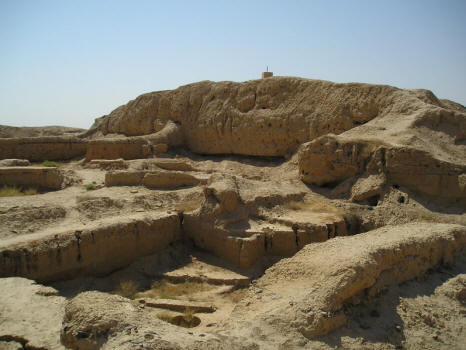
THE CITY OF LOVE
Mari’s Amor-ite city or ‘City of Love’ of Mari was considered as one
of the wonders of the ancient world.2 It was the Holy Land or power
center until it was conquered by the armies of Hammurabi in 1700 BC.
The people of Mari believed that the universe was the property of a
large pantheon of gods and goddesses who were human in form, but
superhuman in their powers. They believed the goddess Mari lived in
her temple on Earth.
Among the numerous wall paintings and sculptures uncovered at Mari
in Syria archaeologists discovered the jaw dropping 4,000 year-old
three-dimensional, life-size statue of the goddess Mari below.
Called simply The Goddess with a Vase, in this statue Mari is
wearing a coat, a hat and other garments. She holds a water jar in
her hands.
Mari full-length coat is blue, the color of the sea. It is called
the PALA garment or ‘ruler’s garment’. The component PALA is key. It
is the root for palladium, Pala-to, palace and paladin, the name
given to the knights of the Grail in medieval chivalry.
Mari has a cluster of blue stones (apples?) gathered around her neck
and throat area.
The ‘hat’ is no ordinary helmet. It is called the Shugurra helmet.
Whenever attempting to understand or explain The Goddess with a Vase
statue, I turn to (and embellish on) Sumerian scholar and linguist
Zecharia Sitchin. In
his seven books he re-interprets the Sumerian
myths. Shugurra, he says, translates as “that which makes go far
into the universe.” 3
What kind of a helmet or thinking cap is this?!
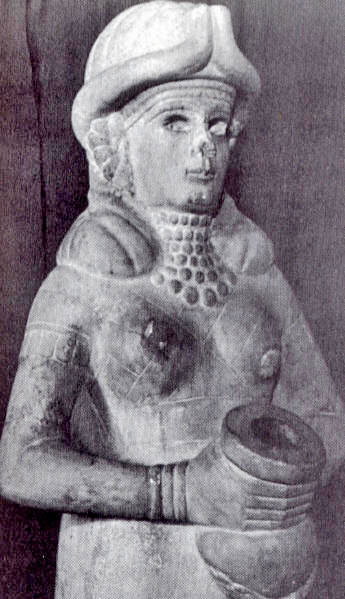
‘The Goddess With a Vase’ statue from Mari, 2000-1500 BC.
Is she
holding the Holy Grail?
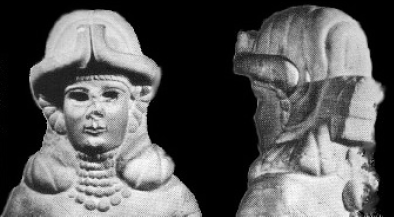
Two straps run out of the TET, a box of rectangular shape on the
back of Mari’s neck, and run across her chest.4 The box is joined to
her helmet, the Shugurra, by another strap. This box is apparently
quite heavy, as evidenced by the straps. A hose is connected to the
base of the box by a circular clasp or buckle. Two identical
‘stones’ adorn her shoulders.
The TET corresponds with the Menat worn by Ptah on the back of his
head and with the TET pillar that is part of the All.
These accoutrements underlined that this goddess was the Queen of
Mari. According to Sitchin, no one has been able to explain the
nature of Mari’s strange ensemble of coat, hat and other garments.
It is too bizarre to think of it as some form of ancient virtual
reality system that assists one in transforming themselves in order
to go far into the universe. But what if that is what it is? What is
this ensemble doing on the body of a 4,000-year-old statue?
Apart from these sensational questions, the question that is most
integral to our search concerns what Mari did once she donned this
outfit.
THE SHEEPFOLD - THE VESSEL OF CREATION
Among Mari’s many titles she was known as Ma-Ya, ‘the Lady of Life’,
or Ma .5
Her temple/womb/sheepfold was considered the vessel of
Creation. With her Shugurra helmet snuggly fitting her head, Mari
goes to her sheepfold, which is the center of nature of Sumer (or
Su-Meru). Leaning against a fruit tree, she rejoices in her own
natural powers --her wondrous vulva.
Within this temple emerged Mari’s son who was named ‘Lord of the
Sheephold’, ‘the Shepherd’, ‘Lord of the Net’, and ‘Lord of Life’.6
According to Sumerian legend, in a night of wild drink and sex,
Inanna/Mari, a cunning and ruthless beauty, seduced the god
E.A and
made off with his prized Key of Life, as well as the divine
ME-tablets, the divine formulas which were the basis for high
civilization.7
That night she also conceived a son, Thoth.
Mari’s name anticipates the Virgin Mary by 3,000 years. Both women
had a son who died a violent, sacrificial death. Mari’s titles
‘Light of the World’, ‘Morning and Evening Star’, ‘Righteous Judge’,
‘Forgiver of Sins’, and ‘Holy Shepherdess’ were later given to
Mary’s son, Jesus.
Jesus said he had many sheepfolds. Among the beautiful treasures
that were discovered at Mari were stone molds for cakes found in the
kitchen of the palace in the shape of the Goddess’ body. The cakes
eaten by the worshippers of the Queen, says scholars,8 may have been
a precursor of the Christian Eucharist the bread and water used at
the Last Supper.
The similarity between Mari’s son and Jesus are striking. Raised by
priestesses in the Vessel of Creation, the half-human, half-divine
son, who was called the Lord of the Net, appears to have been
privileged to learn the secrets of the universe, including those of
the Key of Life.
In Matthew Jesus states the Kingdom of Heaven is a Net.9
When he appears to John he is wearing the attire of the goddess
including a floor-length garment and helmet white as wool. He also
wields Key of Life in the form of the seven stars that he holds in
his hand.10
The creation of Mari’s son is also equivalent to the story of the
creation of the Adam in the Hebrew story. The Sumerians are
considered by many Old Testament scholars to have been the original
authors of the creation myth as found in the Book of Genesis. The
tale of Adam and Eve in the Garden of Eden, particularly the Tree of
Life incident, is also of Sumerian origin.
According to Sumerian myth, Mari/Inanna rescued the Tree of Life
from the world flood and planted it in her garden at Mari. This Tree
was an axis connecting the underworld with Earth and the heavens.1
Mari seeks to use the wood from the Tree to make a throne and a bed.
However, she discovers that the Tree has some unexpected occupants.
A serpent has “made his nest in the tree.” This serpent is not
alone. The “anzu bird who set his young on the branches,” also
dwells within, as does the “dark-maid Lilith” who built her home in
the trunk.12
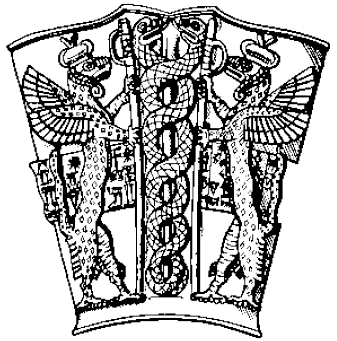
The seal of Mari’s son, Thoth/Ningishzidda.
The entwined serpents
also symbolized E.A.’s son, Ningishzidda (‘Lord of the Artifact of
Life’).
Libation Cup of Gudea, c. 2000 BC
The inhabitants of the Tree -- two snakes named
Lilith and Samuel
--refuse to leave. In temple depictions Mari is pictured holding
these two serpents wound around a rod. Known as the caduceus this
symbol was the logo of a priesthood of Therapeutae, or physicians of
the soul.
This was also the symbol for her son, “the Lord of the Key of Life.”
The figure 8 or the entwined serpents also symbolized him. The
Egyptians changed his name to Thoth,
but retained his sacred number 8.
The Greeks called
Thoth or TAT by
the name Hermes (‘stone’).
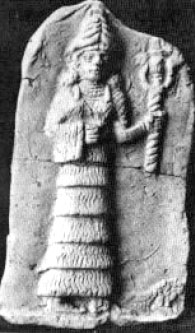
Mari wearing her helme, blue stones, and coat holding the caduceus.
In Amorite legend this tube-shaped serpent’s name is
Yamm, derived
from the Hindu Lord of Death, Yama.13 Mari and this serpent
apparently married, for Mari, who is also called Maya, was
worshipped along with her serpent-husband Ya-Ma, whose name is Ma-Ya
in reverse. Yama means ‘twin’.14
The Hindu Vedas say Yama, Lord of Death, sits in the midst of the
cosmic ocean on the Navel of the Waters, where “matter first took
form.”
Incidentally, the Japanese associated this center with the
Mountain-Mother Fuji the Ancestress. This sacred mountain became
known was Fuji-Yama. From his throne Yama, as the ‘King of
Righteousness’, sips on soma and gives judgment (or balances Heaven
and Earth), much like Thoth.15
In the Judeo-Christian religion Maya’s husband Yama, the serpent,
became a figure the Hebrew scribes did not exactly know how to
handle.
When Moses asked God his name, God replied from the burning bush, “I
am.” 16
He became known as Y-Am or I-Am, the Old Testament Hebrew god who
was also known as
Yahweh or Jehovah. The Pillar depicted in the
Sumerian and Egyptian examples we will look at momentarily are
symbolically equivalent to the Tree of Life of the Garden of Eden
story. Ya-Ma or I Am is the name of the serpent that lived within
it. Logically, the Old Testament Lord and the Serpent appear to be
one.
Despite the Lord’s injunction in Leviticus 26:1,
“You shall make no idols nor graven image, neither rear you up a
standing image, neither shall you set up any image of stone in your
land, to bow down unto it: For I am the Lord your God ” the Hebrews
continuously sought the Pillar, sometimes at the request of I-Am.
In the Book of Numbers, chapter 21,
I Am said to Moses,
“Make thee a fiery serpent, and set
it upon a pole: and it shall come to pass that everyone that is
bitten when he looks upon it shall live. And Moses made a
serpent of brass, and put it upon a pole, and it came to pass,
that if a serpent had bitten any man, when he beheld the serpent
of brass, he lived.” 17
Jews and Christians later remembered this duo, combining their names
Maya and Yama into one, Mari-Yama or Mariam, the name of the mother
of Jesus.18
In the Gospel of John Jesus speaks directly of this serpent,
“And as Moses lifted the serpent in
the wilderness, even so must the Son of Man be lifted up: That
whosoever believeth may in Him have eternal life. For God so
loved the world, that He gave his only begotten Son…”
19
Let us now look at the Sumerian and Egyptian depictions of the
Tree
of Life. The TET box on the back of Mari’s helmet, which she wore
when entering her sheepfold, appears to serve the same function as
Ptah’s menat charm. It connected her to the TET pillar. Ptah
sometimes appears standing in front of a TET pillar.
In Egypt, the TET pillars were called “the backbone of Osiris.” In
Egyptian mythology, Osiris is the green-faced savior god. He, along
with his wife Isis, came from Sirius and taught the art of
gardening.
They were profusely illustrated in ancient Egypt. Many of these
depictions survive today (click below image).
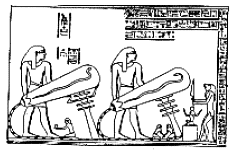
In the illustration above from the Temple of Isis at
Denderah in
Egypt,
a site within walking distance of Abydos, the Egyptian
‘Garden of Eden’,
the TET columns are shown with ‘serpents’ of
current flowing through them.
Some believe these symbolize
electricity.
If so, how did the ancient Egyptians generate electricity?
Modern electrical engineers, physicists readily observe that the
ancient Egyptian religious artwork portrays an object strikingly
similar in design to a modern Van de Graaff Generator.
Designed and built by American physicist Dr. Robert J. Van de Graaff, who was a professor at MIT, this generator was built in 1931
as a research tool in early atom-smashing and high energy X-ray
experiments.
The device that bears his name has the ability to produce extremely
high voltages -- as high as 20 million volts. Van de Graaff invented
the Van de Graaff Generator to supply the high energy needed for
early particle accelerators. These accelerators were known as atom smashers because they accelerated sub-atomic particles to very high
speeds and then “smashed“ them into the target atoms.
The resulting
collisions create other subatomic particles and high-energy
radiation such as X-rays. The ability to create these high-energy
collisions is the foundation of particle and nuclear physics.

In 1931, the large Van de Graaff generator was constructed
in an
unused dirigible dock at Round Hill, Massachusetts.
Photos © MIT.
Modern physicists readily notice that these pillars bear an uncanny
resemblance to cathode ray tubes.
Developed in the 1870’s by
Sir
William Crookes, an English physicist and chemist, the tube was
integral to the study of what came to be called cathode rays.
Cathode-ray tubes are glass tubes with the air sucked out of them.
Metal plates are sealed at either end and then connected to a
battery or an induction coil. When charged with electricity, the
vacant areas in the tubes glow. Crookes concluded that invisible
rays from the cathode caused the glow. The glow emanated from the
negative plate --the cathode -- and disappeared into the positive
plate -- the anode. Significantly, Cat-hode comes from the Greek
kathodos, going down, from kata, meaning ‘down’ and hodos, way.
Cata
is also the root for Cat-har and Cat-holic, meaning ‘universal’.
What are these “serpents”? The ancient linguist, poet, and holy man,
King Solomon, might remind us that in Hebrew nahash is the word for
serpent and wisdom. The Hebrew word for soul is neshamah. The
linguistic and phonetic similarity of these words would force a
question in Solomon’s poetic mind.
Are the ancient Egyptian artists
asking us to link these serpents with souls?
“I TAWT I TAW A PUTTY TAT”
The “patient” on the operating table beside the TET or TAT does
appear ready to receive the contents of the tube or jar. The
“doctor” holding the cutting knife has the head of a cat.
Following our pattern of investigating word meanings, I find it
fascinating that kathodos contains the element Os, or Osiris.
Equally prominently it displays kat or cat. In the Egyptian story of
Osiris, the Primordial Garden of Creation housed a World Tree or a
Tree of Life linking Heaven and Earth. To the Egyptians this tree is
also known as the persea tree. The tree is shaped like a spade, the
tool of the gardener, and is accompanied by a cat, giving rise to
the notion that it is a “pussy tree.”
According to the story told by the priests at Heliopolis, Egypt, the
cat is another form of Ra-A-tum, the name the Egyptians gave to the
spark of life (the Akh) that releases the infinite energies of Nun
(creation).
Why the cat? As noted, the Egyptians were fond of word play and
puns. Electricity that spat and hissed and bit and numbed became
depicted as a cat. In order to free itself from the serpent’s coils,
A-tum (or A-tom) took the form of a cat and killed the serpent by
splitting it with its knife. When the cat (atom) splits the serpent
the persea tree emerges from within it.
The cat’s persea tree can be treated a number of ways in the
Language of the Birds. For example, what is the relation of the
cat’s purr to the per-sea tree? What is the significance of the fact
that Mary Magdalene is the patron saint of perfume? What
significance, if any, is there to the fact that the Grail Stone is
also known as the “Pearl of Great Price”? Was a play on words
intended when the Cat-hars called themselves the Pure or Purr Ones?
In the hieroglyph of Osiris two ‘TET’ pillars are featured on either
side a mysterious object that resembles the Hebrew Ark of the
Covenant. Beside them is Osiris’ Pillar of Love (far right). The
Pillar of Osiris stood approximately forty feet tall and was lined
with gold.
This pillar contains what appears to be a serpent.
However, we are told it actually contained the “head” of Osiris.

The hieroglyph of
Osiris
When the Pillar is mounted to the portable stand which resembles (in
form and likely in function) the Biblical Ark of the Covenant a
device of enormous power is created. It is a golden needle or
antenna that ties the ‘thread’ (cord, chord) between the upper world
and the lower worlds.
ROSTAU
The ancient Egyptians called the complex where this procedure took
place the Ros-tau.20
This is another word for
Giza. The Giza-Rostau
complex was at the end of the ‘sacred road of the neters,’
suggesting it was a passageway used by the gods to enter the
underworld (also called the Tuat).
While many will consider the notion that Mary Magdalene was
continuing the teachings of Mari pure speculation, it is fascinating
to note that several Christian researchers are beginning to take a
serious look at the similarities between the symbolism and teachings
of Jesus and Osiris and his Tree of Life.

The Pillar of Osiris
Osiris’ pillar was considered a ladder to heaven. This ‘ladder’ is a
symbol of that which must be ascended in order to reach the Fields
of Peace.
In
the Pyramid Texts, in which the pharaoh’s journey to immortality
is described, the two TET pillars are shown on either side of the
“Door of Heaven.” The doors remain sealed until the pharaoh utters
the word of power. Then, suddenly, the “double doors of heaven open
up… the aperture of the celestial windows is open.” And soaring as a
great bird, the pharaoh’s Ka has reached the land of the living.
A startling correspondence between the crucifixion of Jesus and the
Pillar of Osiris is found in the definition of the Greek word
stau-ros. While unfamiliar to most modern Christians, it was the
original Greek word used to describe the Cross upon which Jesus was
crucified. It actually means the 'pillar'. The mirror image of this
word is ros-tau, one Egyptian term for the Sphinx.
The word “cross” did not appear in the Bible until after 500 AD.21
This explains why the “Latin” (Roman) or “Passion” cross, the
primary icon or logo of Christianity, did not appear in Christian
art until 600 AD either.22
In the original Greek version of the New Testament the word used for
the Pillar upon which Jesus was Crucified was Stau-ros.
In Egypt tau was another name for the ankh, the Cross of Life.
Ros
means wisdom and dew.
Amalgamating these word meanings, renders Stau-ros as “the Pillar or
Cross of Life or Wisdom,” perfectly aligning it with the Egyptian
term for the wise ‘blood of life‘ provided by the ankh or Key of
Life.
One of the most powerful symbols of Christ is the phoenix. In
Egyptian symbolism the phoenix is interchangeable with the heron.
The heron (phonetically hare-on) was the symbol for the
sun-bird-man, the savior figure, that landed atop the Persea Tree of
Heliopolis or On at the dawn of each New Age. Heliopolis was the
name of the city where Jesus was taken during the ‘flight to Egypt’.
The heron was a title for Osiris. Budge says Osiris was also called
Un-Nefer, a name that means ‘beautiful hare’ or ‘good being’.23 He
also says Un-nefer comes from un ‘to open, to appear, to make
manifest’, and neferu ‘good things’ (a related word is neteru, or
god-beings). Isis was known as the Great Goddess Har, the patroness
of temple prostitutes or harines.24
Like the Greek
horae and other
holy harlots, her priestesses occupied the part of the temple known
as the Harem, the Sanctuary. In order to rule, kings had to prove
their virility by impregnating the harines, creating a semi-divine
offspring who were half-human, half-heron, i.e. bird-men or
angels.
The harines explain why Mary Magdalene was known as a harlot. It
also provides an explanation for why the resurrection of Jesus, is
associated with the Easter bunny. The answer probably has something
to do with the fact that Easter is a lunar holiday, occurring
precisely on the first Sunday after the first full moon of the
Spring Equinox.
The other reason is because of his connection to Osiris.
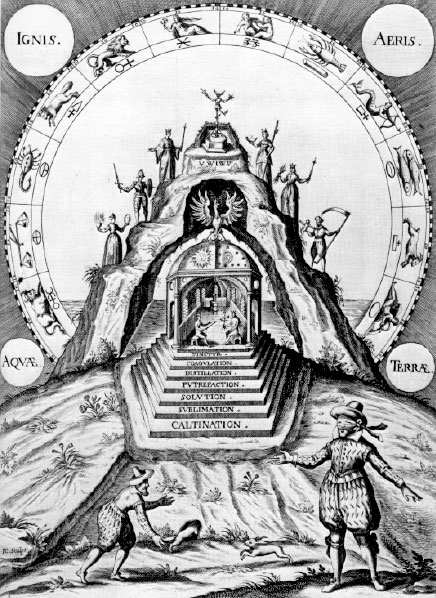
The Cave of the Altar.
A hare enters the magic mountain where the
phoenix is waiting.
The result of this alchemical procedure is the
creation of Hermes,
seen dancing at the top of the mountain,
caduceus in hand.
The Egyptians said Osiris, as a hare, guards one of the Seven Halls
of the Underworld.25 In the story
Alice in Wonderland Alice chases a
hare down a hole -- which turns out to be a gateway to another
world. The name for the Egyptian underworld was the Tuat. Sometimes
Osiris was depicted with his body bent around backwards so as to
form the Tuat.
The Seven Hall of the Tuat are reminiscent of the Hindus legend of
Fohat, a serpent who dug ‘holes in space’.26 These theorists tell us
that ‘below’ the Earth are seven intermediate points or cavities: Atala, Vitala, Sutala, Talatala, Mahatala, Rasatala, and Patala.
This, in turn, rings of the Mayan legend of the ‘Seven Cities of
Cibola’ (or Sa-Ba-La), which were the seven caves or holes of
Aztlan, Atlan, or Tula.
In one of these holes, Patala, dwells the
Lord An-an-ta, the primeval Hindu god, intoxicating all with drops
of fragrant honey from his fresh tulasi flower.
THE TELI OR TULA
In the above sentences we notice the repetition of the words talah
and Tula.
Talah means “to hang.” In the mysterious Jewish alchemical text, The
Bahir, Teli (derived from talah) is the name of the connecting link
that will enable our soul to return to its home.27
It is often described as a pillar or pole between Earth and Heaven.
In Christian mythology this was the Tree of Death, or the Cross upon
which Christ died.27 In fact, both Christianity and Egyptian
religion employ the tree in the contradictory terms of death and
life. Jesus hung from the Tree of Death, the Cross, but in so doing
became the Tree of Life.
Other authorities identify the Teli with the “Pole Serpent”
mentioned in the book of Job, “By His spirit, the heavens were
calmed, His hand has pierced the Pole Serpent.”28
This Pole Serpent is imagined as an imaginary creature from which
the Earth hangs. From another perspective, where the Hebrew words
for serpent and soul are interchangeable, the Teli may refer to a
Pillar from which hangs a serpent-shaped soul sphere.
This is exactly what the book of John 3:15 says,
“And just as Moses
lifted up the serpent in the wilderness, so must the Son of Man be
lifted up, that whoever believes in him may have eternal life.”
The Greeks called the Milky Way’s Central Sun Tula (Sanskrit for
‘balance’). They were not the only ones to possess knowledge about
Tula. The Druids said they came from Hyperboria. At the center of
this heaven ‘beyond the north wind’ was Tula, the Druid mecca for
learning.
Whenever we see the T-L-A letter combination in a word or sprinkled
throughout a word it is a reference to Tula.
Like the Hebrew scribes, the Druid Bards were masters of word play
and the mixing of word elements. Identifying the T-L-A elements of
Tula embedded within key mythic names and place names helps us to
uncover the sacred teachings of the galactic core hidden in many
myths and religions.
There used to be mystery schools called Tulas all over the planet --
in Egypt, India, the Americas where physicians of the soul could
gather to learn the way of god making and the means to become ‘one’
with God, and hence “new” or “numan being.”
Among the earliest and most renowned of these resurrection mystery
schools were those of the Egyptian goddess Isis. God making was her
business. The myth and science of Tula was the core of this
teaching.
30,000 light years from Earth is the galactic core, the Central Sun,
Tula.30 This is the heart of our galaxy, not the Sun at the center
of our solar system. As the moon and Earth revolve around the Sun,
so does our entire solar system orbit the galactic core of our
galaxy (which is believed to be in the constellation of
Sagittarius).
The concept of the Central Sun or Spiritual Sun is known by many
different names the world over: the white island, the floating
island, the revolving island, the lost isle in the midst of the
cosmic ocean. This lost isle is not of the Earth. It is the lost
isle, our spiritual core, floating in the sea of heaven.
According to Greek myths, the heart of the Central Sun beats and
vibrations spread through the galaxy. This Central Sun is a fountain
of ‘living waters’, healing ‘waters’ or of healing energy. It is
even considered to be the Holy Grail, the cup of life, itself.
Ancient wisdom traditions maintain humans, and all other beings in
our galaxy, emanate from and share a common home: the Central Sun at
the core of our Milky Way galaxy.
In 1618 artist Matthieu Merian incorporated many of the images we
have encountered thus far in his painting called Tabula Smaragdina
(Latin for “Emerald Tablet”) which was the title page for Daniel Mylius’s book
The Medical-Chemical Work.
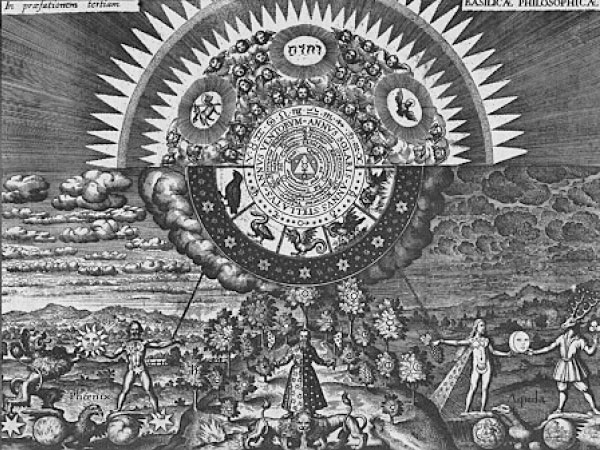
The Emerald Tablet engraving, a powerful mediation for alchemists
who claimed it depicted the (S)tone of God leaving Heaven (Tula) and
entering Earth.
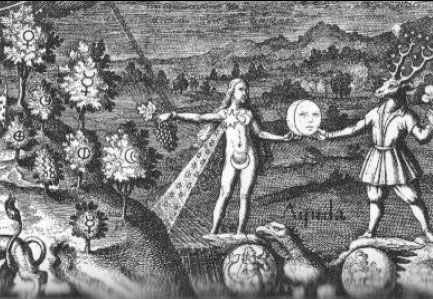
Detail of the Emerald Tablet
In this detail of
the Emerald Tablet we notice a naked woman
standing beside a man with the head of a reindeer (Rennes is French
for reindeer).
A cluster of grapes or Blue Apples, the symbol of the
pre-flood nuclear secrets, dangles from the naked woman’s hand. Her
right breast is a small seven-rayed sun from which stream a shower
of stars. She is the core pouring her energies into the river of the
Milky Way galaxy (which she straddles) and the Earth.
Also known as Luna, the Latin name of the Moon-goddess, she was
coupled in Gnostic symbolism and magic texts with Sol, the male sun
who stands on the other side of the hill. Together they represent
fire and water, whose combination produced the Blood of Life.
In the Anacalypsis,31
Godfrey Higgins summarizes the stunning
observations of a German researcher named Heeren and a learned
Frenchman named Abbe Guerin de Rocher. The abbe and Heeren had noted
the similarity between the Scriptures and Egyptian Mystery School
teachings.
In Egypt, they found the Ark of the Covenant, the cherubim with
their extended wings, the holy candlesticks, the shew bread or
Manna, and many other power tools revered by the Jews. He even
noticed that the word used for the name of Thebes is exactly the
same word as that used to describe the Ark of Noah. The same
mythologies are being described.
From this vantage point Heeren and the abbe de Rocher peered into
the story of the Savior crucified in Egypt. The story begins with
Abraham, whom the abbe finds in Egypt under the name Binothris or
Ben-Terah, son of Terah (Abraham’s father’s name, which is the same
as terra or Earth).
A king named Tulis succeeded this Binothris or
Abraham. The son of Terah (phonetically ‘terra’ or ‘terror’) is said
to have established the first queen in Egypt, or to have first
recognized females as royalty. This queen’s name was Sarah. The word
Tulis means ravisher in the Hebrew and Arabic. Thus Tulis was the
ravisher of Sarah.
“The history of this Tulis, as given by Suidas, is very remarkable,”
says Higgins. He quotes Suidas,
“Thulis reigned over all Egypt, and
his empire extended even over the ocean. He gave his name to one of
its isles (Ultima Thule).”32
Puffed up with success, he went to
consult the oracle of Sarapis (known to the Egyptians as Asar-Hapis
or Osiris-Apis).
He asked the oracle if there were any man greater
than Thulis. The oracle replied that God, the Word, and the Holy
Spirit are more powerful. He then told Thulis to go away for he has
an uncertain life.
Immediately upon leaving the temple Thulis was put to death by his
countrymen, the Egyptians.
“But the most remarkable part of this
story,” says Higgins “is that the word Tulis means crucified.”33
Further, says Higgins,
“Here in the country of the Africans --in
Egypt we have again the crucified of the Apocalypse. Thlui or Tula
is the name given by the Jews to Jesus Christ, meaning the
crucified.”34
Jesus, the crucified, means Jesus of Tula? I realize
Higgins’
statement may come as a shock for some. Some will say I am
connecting unrelated words and stories. I don’t think so. I have
given the basis for doing so, and have established Tula as the
source of all myth and religion. So why not the myths of Jesus too?
Fascinatingly, the Old Testament word for ‘virgin’ was ‘bethula’.
Literally it means beth ‘house’ or ‘vessel’ of Tula.
While on the subject of adding word meanings together, it is
important to note that earlier we found that Elizabeth Van Buren
said that Thule (Tula) means “black land.” This is another
definition of the word ‘Egypt’. If, as Ms. Van Buren says, Rennes is
Egypt, then Rennes and Egypt may also be Tulas.
THE GREEN MAN
The Greeks recorded that the Green Man or Gardener is the immortal
ruler of Tula and Hyperboria,35 the Greek name for heaven. This
suggests the Green Man or Gardener is the King of Tula.
The Green Man or Gardener is a powerful mythic image known to every
civilization. He is depicted with vegetation symbolizing the Life
Force or Word of God spewing from his mouth. He is known by many
names throughout the world: Adonis (Greek, Roman), “the Lord,” and
Dionysus are a few of his names. 36
Unbeknowest to many, it is quite possible this figure was present on
Easter morning along with Jesus.
On Easter morning, in the Book of John,37 Jesus appeared to Mary
Magdalene along with a mysterious figure that she called “the
Gardener.” Evangelists and scholars alike assume this Gardener is
Jesus. What if it is not Jesus? Have you ever seen a depiction of
Jesus with his face painted green?
If he is not Jesus, can we identify the Gardener?
Yes. In the Islamic tradition, a highly revered mythological figure
is shown wearing a shimmering green robe, and is the ‘Guardian of
the Source of the Waters of Immortality’. He is called Al Khidr, the
Green Man or the Evergreen One. The Islamic people believed
Al Khidr
was Elijah! 38 Didn’t Jesus
say John the Baptist was the reincarnated Elijah? 39
If John is the Green Man, why didn’t the Gospels simply say so? Or,
when they said the Gardener was there did they expect us to
understand who they were talking about? If it is an intentional
omission, why would the editors of the New Testament story of Jesus
omit a crucial detail such as this?
It is vital that we attempt to piece together Jesus’ story, for
if
the Gardener is the King of Tula it suggests that Jesus found some
way to travel to this location in order to bring him back to Earth.
My proposal is that the Crucifixion was a stargate event. The
Shroud
of Turin is the evidence. In the next chapter we will examine this
piece of evidence. Before doing so, it is worthwhile to briefly
consider the story of Alexander the Great (c. 330 BC), another
seeker of the secrets of immortality.
ALEXANDER AND THE GARDENER
Throughout his career Alexander summoned the power of the Green Man.
He believed the tales of this wandering god, who the Greeks called
Dionysus, and who sailed the seas in a ship with clusters of grapes
hanging from its masts. As a god himself, Alexander sought to out-do
his predecessor in every way possible.
According to one legend,40 Alexander was once alone in the desert,
when suddenly; a ‘spirit’ that carried them into a heavenly abode
atop Mount Meru seized him and his horse. (According to Muslim
legend, a thousand years later Mohammed was also carried to the same
place by his white horse.)
Atop Mount Meru Alexander discovered a structure that glittered
with a golden staircase with 2,500 steps and two huge pillars some
sixty feet in height. Here, seated on a couch, Alexander encountered
a shining green being whom he described as “a flaming fire,” a
description which matches that of Moses’ recollection of the God
named “I Am” who talked with him from behind in the flaming or
“burning bush.” (Fire, the Blue Apples muse whispers, is
frequency,
vibration, knowledge.)
Nearby, Alexander saw this being’s golden rod, the key Secret of all
mysteries -- the branches of a vine with a cluster of grapes at the
top.
The Green Man seemed puzzled to suddenly find himself in the company
of a human being. He asked Alexander how he was able “to penetrate
into this darkness, which no other man hath been able to do.”
Alexander responded that god himself had given him the means (the
uraeus of the Pharaohs or the Key of Life) to make the journey to
this place. Where is Alexander? In one version of the story the
place of darkness is called the Cave of the Gods.
In another version, Alexander is told that he has arrived at “The
City of the Storehouse of Life,” from where the “Bright Waters of
Life” originated. This is the place from whence the living waters
(or living souls), the Holy Light, emanated. According to the
Greeks, the Green Man is the King of Hyperboria,41 the Greek name
for Heaven.
At the center of Hyperboria is found a mecca for
learning called Tula. This land, according to renowned French
mythologist Rene Guenon,42 was the Garden of Eden of our race. The
Green Man is the Gardener of the Eden.
Judging by the conversation, Alexander seems to have annoyed the
Green Man who kept trying to get Alexander to leave. Alexander
agreed to grant the Green Man’s wish but only if he were allowed to
learn something that no man had ever known before.
Fair enough, the
Green Man told him:
“I will tell thee something whereby thou mayest live and not die...
In the land of Arabia (although it could be anywhere), God hath set
the blackness of solid darkness wherein is hidden a treasury of this
knowledge.
There too is the fountain of water which is called ‘The
Water of Life’; and whosoever drinketh therefrom, if it be but a
single drop, shall never die.”
This living water (wisdom), said the Green Man, could even give men
the power to fly through the heavens like the angels.
As angels fly
on the wings of their bodies of light, it is obvious this drink had
a transformative effect on the human body. Alexander could hardly
contain his excitement, anxiously asking where in the world he might
find this fountain of life. Where is it?
Find and ask the heirs to this knowledge, replied the Green Man to
Alexander.
Then, most importantly, the Gardener handed Alexander a cluster of
grapes to feed his troops.
At that instant, with the Blue Apples in his hand, Alexander held
the secret of immortality. He thought he knew enough. Alas,
Alexander died of a fever in Babylon. His coffin has never been
discovered.
Back to
Contents
|











